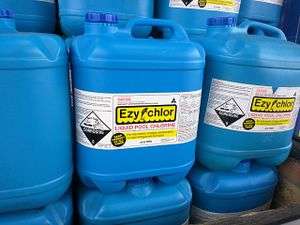Chlorine gas
Background

Liquid Pool Chlorine
- Classified as a pulmonary chemical agent, chemical weapon
- Most common exposure is secondary to mixing household cleaners
Mechanism of Toxicity
- Direct caustic / corrosive effect upon contact with moist tissue
Clinical Features
- Smells of a swimming pool or bleach
- Irritation of conjunctivae, nose, pharynx, larynx, trachea, and bronchi
- Rare ocular injury as tears protect mucous membranes from direct damage
Differential Diagnosis
Chemical weapons
- Blister chemical agents (Vesicants)
- Lewisite (L)
- Sulfur mustard (H)
- Phosgene oxime (CX)
- Pulmonary chemical agents (Choking agents)
- Incendiary agents
- Cyanide chemical weapon agents (Blood agents)
- Prussic acid (AKA hydrogen cyanide, hydrocyanic acid, or formonitrile)
- Nerve Agents (organophosphates)
- Acetylcholinesterase inhibitors
- Household and commercial pesticides (diazinon and parathion)
- G-series (sarin, tabun, soman)
- V-series (VX)
- Lacrimating or riot-control agents
- Pepper spray
- Chloroacetophenone
- CS
Evaluation
- Based on clinical history
- Specific levels are not available
Management
- Individuals with gas exposure may not need decontamination, if skin symptoms absent
Disposition
See Also
External Links
References
This article is issued from
Wikem.
The text is licensed under Creative
Commons - Attribution - Sharealike.
Additional terms may apply for the media files.